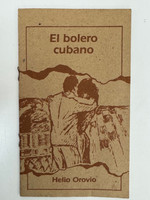- Travel
-
Exhibits
- La Portada Cubana
- Immortal Cuba: Artists Take on Their Heroes
- Seattle Poster Exhibit
- Sandra Dooley & Alejandrina Cué
- The Art of Wayacón
- Cuban Folk Art
- Cuba In Black And White
- 25 Years of Cuban Art Space
- Summer Folk Art Expo
- ¡SPRING AWAKENING FROM CUBA!
- Celebrating The Art Of Cuban Women
- Celebrating Paper, Affordable Art from Cuba
- Art of the Revolution
- Outsider Art
- Lost and Found
- En la lucha: Celebrating Cuban Women and Their Art
- Cuban Art Stash
- 100 Fires: 5 Cienfuegos Artists' Work on Paper
- Waya + Monte! Magic Realism in Cienfuegos
- Viva Cuba Viva! Poster Show
- Cultivando Sueños
- Black Lives Matter in Cuba Jan 9-March 27
- Leandro Soto: Crónicas visuales
- Cuban Canvas
-
Archive
- Global Reflection 2018: Spirit and Community
- Exhibit in the cloud: Contemporary Works on Paper
- MADE IN CUBA! MINNEAPOLIS EXHIBIT
- Cuban Posters and Photography from CCS collection
- AUTUMN SALE! Sept/Oct 2017
- SPRING ARTS AND CRAFT SALE
- Vuelo Directo/Non Stop: Alberto & Alejandro Lescay
- The Many Faces of Fidel
- Somos
- Made in Cuba!
- The US empire in Cuban graphics
- Made in Cuba/Seattle exhibit
- Entre Nos
- Looking Back
- Cuban Art Space
- Membership/Donate
- About Us
- Cuba News
-
The cover design features one of the most iconic images of Cuba's 1961 literacy campaign—a young brigadista photographed in dramatic chiaroscuro, arm raised triumphantly while holding a kerosene lantern, the symbol of bringing enlightenment to Cuba's rural darkness. A bold diagonal gold brushstroke sweeps across the gray-blue duotone photograph, adding dynamic energy to the composition while echoing the revolutionary optimism of the campaign. The stark, documentary-style typography in heavy sans-serif capitals announces "METHODS AND MEANS UTILIZED IN CUBA to eliminate illiteracy (UNESCO REPORT)," positioning this publication as both celebration and serious pedagogical study. The worn, aged cover with its rough-cut edges speaks to the document's historical significance and extensive circulation among educators and solidarity organizations worldwide.
At the request of the Cuban government, UNESCO dispatched a mission to study Cuba's literacy campaign and post-literacy education programs. The mission, led by Mrs. Anna Lorenzetto and Professor Karel Neys, remained in Cuba from February 27 to March 27, 1964, visiting schools, examining documents, and conversing with leaders of the campaign. This second edition report, printed by the Instituto del Libro in Vedado, Havana, provides a comprehensive analysis divided into three parts: Antecedents of the Literacy Campaign, The Literacy Campaign itself (including its four stages from preparatory through final), and Worker-Farmer Education programs designed to raise the educational level of newly literate adults.
The report documents one of the twentieth century's most ambitious and successful mass education mobilizations. Cuba's 1961 Campaña Nacional de Alfabetización mobilized over 100,000 young volunteers—many of them teenagers—who left their urban homes to teach reading and writing to nearly one million illiterate Cubans, primarily in rural areas. The brigadistas, identifiable by their uniforms and iconic lanterns (used for studying and teaching in areas without electricity), reduced Cuba's illiteracy rate from approximately 23% to less than 4% in a single year. The report details the campaign's technical structure including the National Literacy Commission, the creation of teaching materials like the primer "Venceremos" (We Shall Overcome) and the manual "Alfabeticemos" (Let's Teach Literacy), the organizational infrastructure involving Provincial Literacy Commissions and mass organizations, and the revolutionary vanguard's role in accelerating the campaign. Part III examines the critical follow-up programs ensuring newly literate workers and farmers continued their education, recognizing that literacy alone was insufficient without structures to maintain and expand these skills. This UNESCO report served as both validation of Cuba's achievement and a blueprint studied by developing nations worldwide seeking to replicate Cuba's literacy campaign model.
-
-
Discover More at the Center for Cuban Studies







